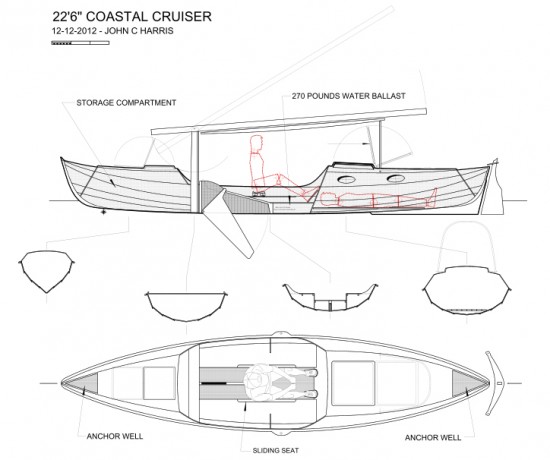Two Faerings for Sail and Oar
by John C. Harris
February 2013
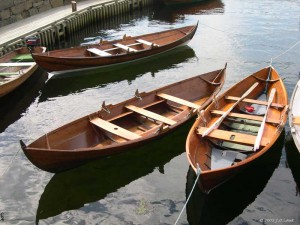 |
| Rowing/sailing faerings of the Oselvar type. Photo courtesy Vikingskip.com |
A faering is a small lapstrake double-ender indigenous to Scandinavia. The design has not changed a great deal in a thousand years, which suggests that when you get something right there's no use fiddling with it. I know I find faerings absolutely intoxicating. There is an elemental simplicity, with not a single extraneous piece of wood. You can't show me a shape better suited to the sea and the oar and the wind. Those clever Vikings figured out how to fasten together a couple of wide planks in a way that combines a fine underbody with plenty of reserve stability topsides.
I've always wanted to have a go at a stitch-and-glue faering. A traditional faering is monstrously difficult to build, but the type does share the essential features of stitch-and-glue boats. In a faering, prefabricated planks are given a sculptural shape that folds into a boat when riveted together. The framing is dropped in later. In a stitch-and-glue boats, flat plywood planks are given a sculptural shape that folds into a boat when stitched together, with frames added later. We can make this work, right?
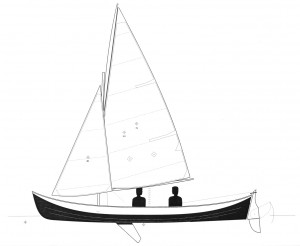 |
| The 19'8" CLC Faering |
My first few attempts looked cartoonish, until I divined the peculiar line-off scheme of a proper faering's planks. Instead of planks of even width that sweep up to the ends in nice concentric curves, like an American Swampscott dory, the sheer plank on a faering is wide amidships and pinched at the bow. This was counter intuitive to me as an American designer, until my software "unpeeled the banana" and I eyeballed the flat planks. Those Vikings! Arranging the plank line-off that way means that the four planks making up each side of the faering hull have only a little bit of sweep. This saves a lot of material. Done like a round-sided dory, you end up with deeply-curved individual planks, shaped like a single parenthesis, which waste a lot of wood.
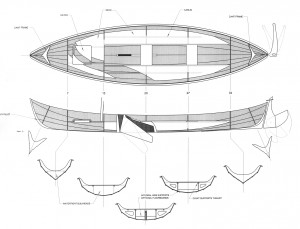 |
| The CLC Faering weighs about 300 pounds. This would be a first-class beach-cruising machine. |
On spec I designed a nice beach-cruising faering, 19'8" long. I wasn't trying to create a pious replica of the Norwegian type, which when swamped are impossible to bail out. I added in seats and tankage, for comfort and safety, and instead of a shallow keel there's a modern centerboard.
19'8" SOUNDS big, but measured by volume it's a small boat. Faerings are very fine-ended, which gives them their wonderful speed and tracking. The fine ends rob the boat of flotation, however, so a 15- or 16-foot faering would have a disappointing payload. My 19'8" faering has a useful capacity of about 800 pounds, good enough for a daysailing family, or for serious camp-cruising. One person can sleep on the floorboards, or a cruising couple could sleep aboard if they spanned the footwell with removable panels to create a sleeping platform.
I was taken with the resulting drawings, but the project ground to halt, as most of my speculative doodling does, because it was going to be very costly to prototype, document for an instruction manual, and turn into a Chesapeake Light Craft kit.
In September 2008, Norseboat, the Nova Scotian outfit that has been turning out exceptionally capable beach-cruisers for many years, approached CLC about a partnership. CLC would design and manufacture stitch-and-glue versions of their boats in kit form, and Norseboat would handle the marketing. I was enthusiastic (then and now), but the complexity of their stock designs made me apprehensive. I offered up my 19'8" faering as a somewhat simpler design to try out the logistics of our partnership. The design was a perfect fit with Norseboat's lapstrake open-boat-cruising ethic, and it certainly has Nordic vibes.
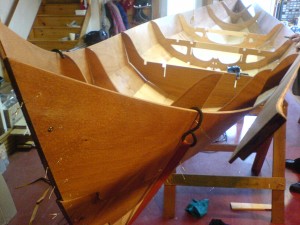 |
| Stitching up one of the early CLC Faering prototypes. This is definitely pushing the boundaries of the amount of shape you can manage in a stitch-and-glue boat. |
Between 2009 and 2012, three of the boats were built to various shades of refinement. Norseboat assembled the first one, which resides at CLC, as yet unfinished. The second one was built as a pure rowing boat by an athletic couple in Scotland. They did a beautiful job, adding some flourishes of their own, and by all accounts have had grand adventures around that rugged coast.
A third version, probably closest to what a production kit would look like, was assembled by a courageous and patient "beta builder" in upstate New York. He's awaiting warm weather for sea trials.
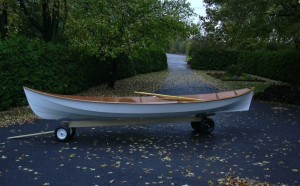 |
| Faering Hull #3, almost ready for its rig. |
The CLC Faering goes together okay, although there's a tough twist in the planking at either end. That twist is intrinsic to traditional faerings---they have to steam the planks in the real thing, of course. You can just manage it in 9mm okoume plywood if you give the planks a good soaking in hot water before you stitch up the hull. The seat-tanks provide stiffness, storage, and safety in the form of positive buoyancy, but also require patient fitting and some very long, very big epoxy fillets.
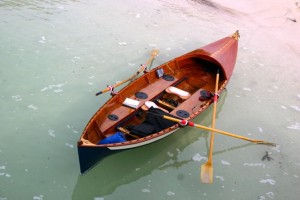 |
|
CLC Faering built in Scotland for beach cruising, |
Norseboat had by now realized what they were in for in terms of creating an instruction manual adapted to amateur boatbuilders, and graciously withdrew. For the moment, the CLC Faering kit is on hold, until we find time to build one from start to finish in our shop, snapping photos the whole way. Only basic plans exist, and even then nothing that the folks at home could work from, alas. It would certainly be an expensive kit, mitigated only by the fact that it's the only relatively easy-to-build faering in the world.
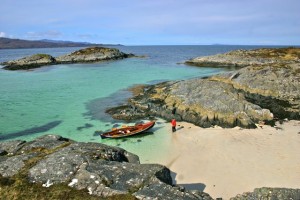 |
| Beach cruising with the Faering in Scotland. Beautiful! |
There's a coda to the CLC Faering story. In 2012, an individual came round looking for a custom design for solo coastal cruising and island hopping. He had three rigid requirements: the boat must sail, it must have auxiliary oar power with a sliding seat, and it must have sleeping accommodation beneath a hard deck. My reaction was that he could pick any two of those but not all three, and my first dozen sketches weren't very inspiring. I pointed out that a stock Bolger Dovekie came very close to what he wanted, but that's a design you either like or don't, and he didn't. We stewed awhile. Six months later I lit upon the fembøring, a larger relation to the faering that sometimes featured a sleeping cabin aft. By stretching the 19'8" CLC Faering to 22'6", it was just possible to cram in a small enclosure aft, a sliding seat amidships, and a decent layout for sailing. [Read about the Faering Cruiser here.]
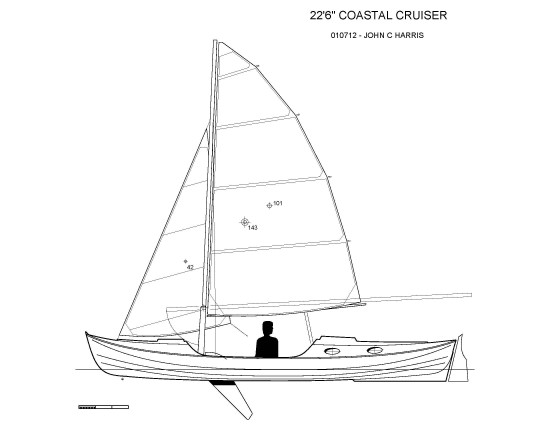 |
| The 22'6" Cruising Faering. These hulls are so easily driven that it doesn't take much sail area. Rigged like this, the boat would be sporty. |
The "Faering Cruiser" is not for everyone, but I confess I'm taken with its shipshape looks. Having cruised hundreds of miles in open boats, I can appreciate having a dry lid over my bedding after a long day in the rain. I would have preferred a "companionway" in the aft bulkhead for easy access, but the client wanted the absolutely watertight seal that a top-opening hatch provides. Thanks to the self-bailing cockpit and tight hatches fore and aft, it should be possible to right the boat and sail away from a capsize.
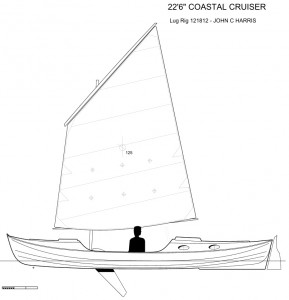 |
| We settled on this balanced lug sail, an excellent combination of good performance on all points and easy handling. |
In order to have even a modicum of performance with a solo oarsman, I had to retain the slack underwater lines of the faering. This will make for spirited sailing when the wind is up. For this reason, we settled on the single modest lugsail, with its low center of effort and all-around efficiency. The sloop would be a little livelier, but this isn't a self-righting boat, so reefing early and often will be the ethic. 270 pounds of water ballast beneath the cockpit help keep her upright. There's plenty of storage for long cruises. The boat is light---about half the weight of the 15-foot PocketShip---so there'll need to be care in distributing the stores for good trim fore and aft.
We started assembling the boat at CLC in December 2012. The Viking DNA is evident even belly-up in our shop. Stretching the LapStitch™ hull from 19'8" to 22'6" made it easier to stitch the hull---the bow and stern posed no special challenges, and the easier bends translated into tight fits for all the CNC-cut parts. As of this writing, there's no momentum to turn this into a kit like PocketShip. The costly and thankless task of documentation for plans and instructions gives us pause. Still, I suspect a design like this would appeal to a few rugged latter-day Vikings.
[Read about the Faering Cruiser here.]
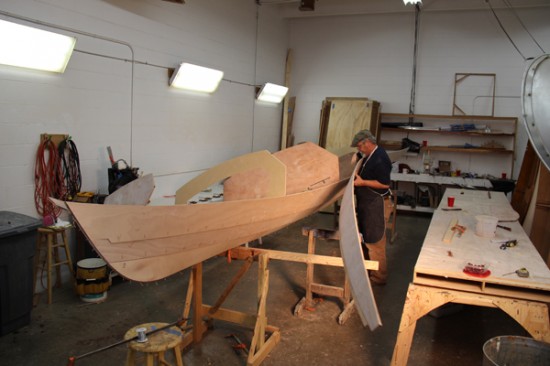 |
| The 22'6" faering was easy to stitch up around a few bulkheads. Hull planking is 9mm okoume. |
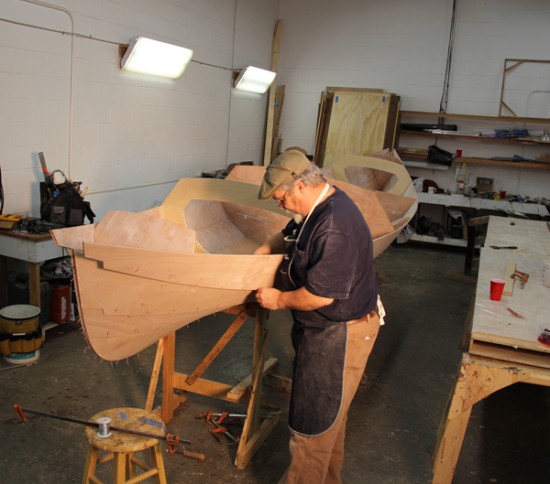 |
| It took a solo builder about a day to assemble the CNC-cut hull. In all we expect the project to consume 700 hours or thereabouts. It'll be sailing in summer 2013. |
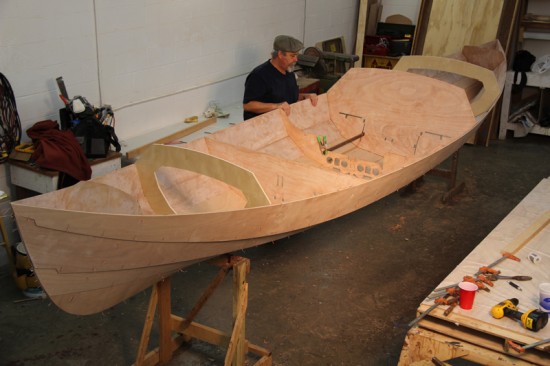 |
| I think the boat retains much of a traditional faering's elegance. Two of the visible frames are temporary. |
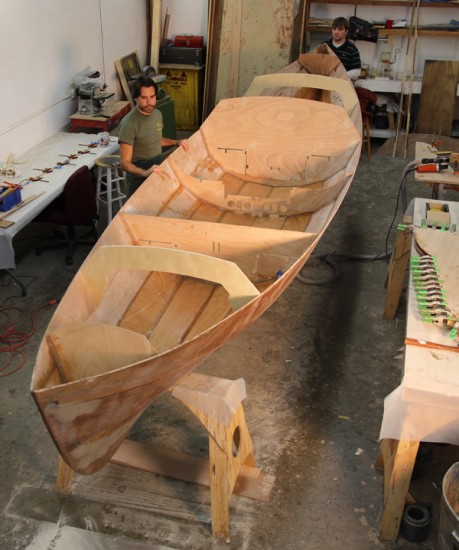 |
| The exterior of the hull is nearly ready for paint. |
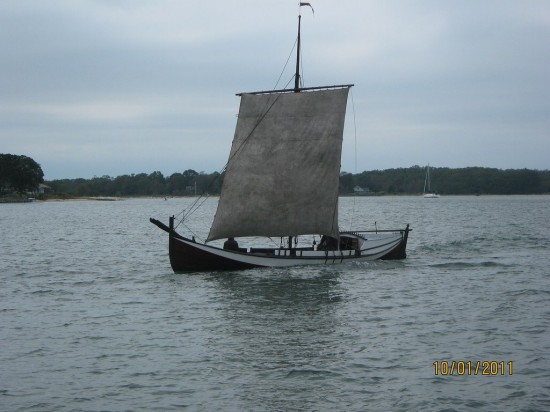 |
| The inspiration for the aft cabin came from a fembøring like this one. |
The completed CLC Faering Cruiser. Several others have been built since. See photos and read about the Faering Cruiser here.
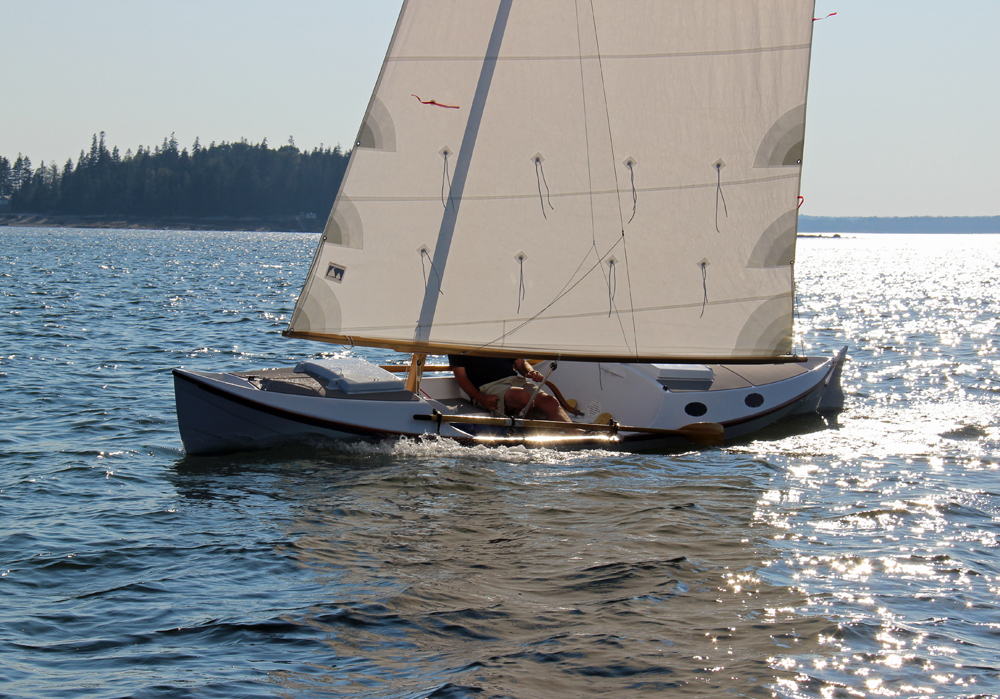


 return to section:
return to section: 